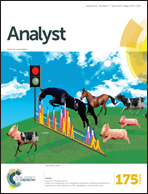Competitive interactions between glucose and lactose with BSA: which sugar is better for children?†
Abstract
The interactions of the sugars glucose and lactose with the transport protein bovine serum albumin (BSA) were investigated using fluorescence, FT-IR and circular dichroism (CD) techniques. The results indicated that glucose could be bonded and transported by BSA, mainly involving hydrogen bonds and van der Waals interactions (ΔH = −86.13 kJ mol−1). The obtained fluorescence data from the binding of sugar and BSA were processed by the multivariate curve resolution-alternating least squares (MCR-ALS) method, and the extracted concentration profiles showed that the equilibrium constant, rglucose:BSA, was about 7. However, the binding of lactose to BSA did not quench the fluorescence significantly, and this indicated that lactose could not be directly transported by BSA. The binding experiments were further performed using the fluorescence titration method in the presence of calcium and BSA. Calcium was added so that the calcium/BSA reactions could be studied in the presence or absence of glucose, lactose or hydrolysis products. The results showed that hydrolyzed lactose seemed to enhance calcium absorption in bovine animals. It would also appear that for children, lactose provides better nutrition; however, glucose is better for adults.


 Please wait while we load your content...
Please wait while we load your content...